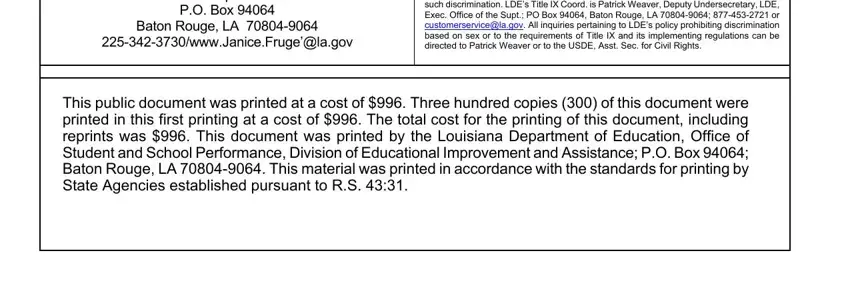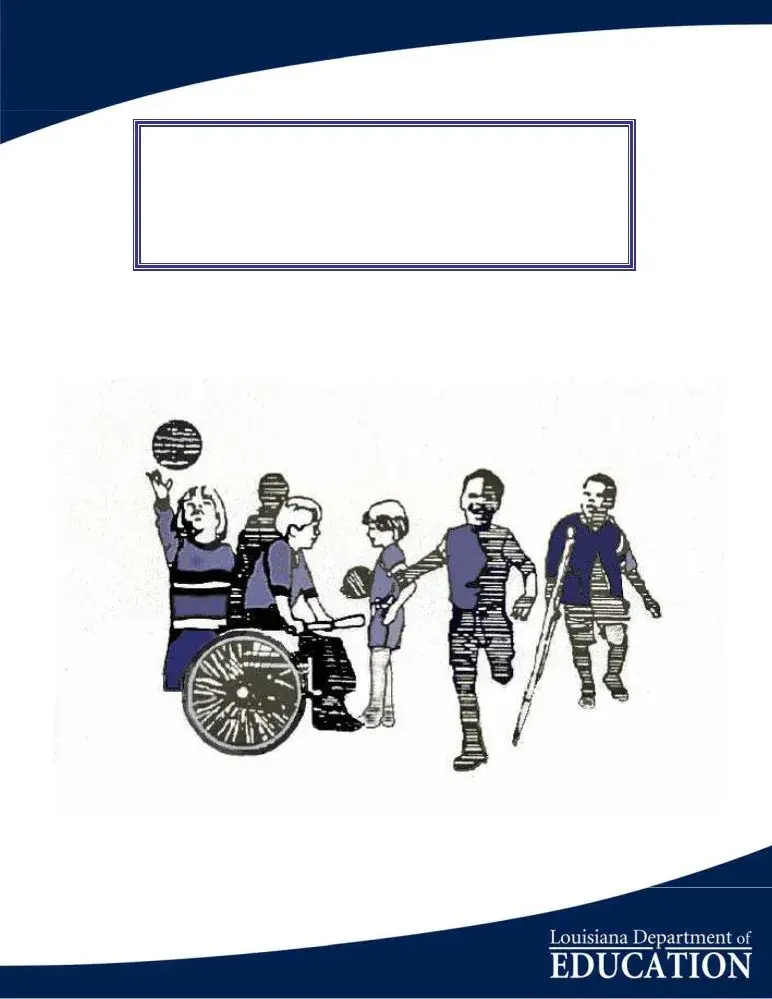CTAPE
Competency Testing
For
Adapted Physical Education
Subtitle Goes Here
Paul G. Pastorek
State Superintendent of Education
Date
Revised 2008
Paul G. Pastorek
State Superintendent of Education
LOUISIANA DEPARTMENT OF EDUCATION 1 . 877 . 453 . 2721 www.louisianaschools.net
State Board of Elementary
and Secondary Education
|
Mr. James D. Garvey, Jr. |
Mr. Dale Bayard |
|
1st BESE District |
Secretary-Treasurer |
|
|
7th BESE District |
|
Ms. Louella Givens |
|
|
2nd BESE District |
Ms. Linda Johnson |
|
|
President |
|
Ms. Glenny Lee Buquet |
8th BESE District |
|
|
|
3rd BESE District |
Ms. Tammie A. McDaniel |
|
|
|
Mr. Walter Lee |
Member-at-Large |
|
|
|
4th BESE District |
Ms. Penny Dastugue |
|
|
|
Mr. Keith Guice |
Member-at-Large |
|
|
|
5th BESE District |
Mr. John Bennett |
|
|
|
Mr. Charles E. Roemer |
Member-at-large |
|
|
|
6th BESE District |
Ms. Weegie Peabody |
|
|
|
|
Executive Director |
|
|
|
|
|
|
|
For further information, contact: |
The Louisiana Department of Education (LDE) does not discriminate on the basis of sex in |
|
Janice Fruge |
any of the education programs or activities that it operates, including employment and |
|
admission related to such programs and activities. The LDE is required by Title IX of the |
|
Division of Educational Improvement and Assistance |
|
Education Amendments of 1972 (Title IX) and its implementing regulations not to engage in |
|
P.O. Box 94064 |
such discrimination. LDE’s Title IX Coord. is Patrick Weaver, Deputy Undersecretary, LDE, |
|
Exec. Office of the Supt.; PO Box 94064, Baton Rouge, LA 70804-9064; 877-453-2721 or |
|
Baton Rouge, LA 70804-9064 |
customerservice@la.gov. All inquiries pertaining to LDE’s policy prohibiting discrimination |
|
225-342-3730/www.Janice.Fruge’@la.gov |
based on sex or to the requirements of Title IX and its implementing regulations can be |
|
directed to Patrick Weaver or to the USDE, Asst. Sec. for Civil Rights. |
|
|
|
This public document was printed at a cost of $996. Three hundred copies (300) of this document were printed in this first printing at a cost of $996. The total cost for the printing of this document, including reprints was $996. This document was printed by the Louisiana Department of Education, Office of Student and School Performance, Division of Educational Improvement and Assistance; P.O. Box 94064; Baton Rouge, LA 70804-9064. This material was printed in accordance with the standards for printing by State Agencies established pursuant to R.S. 43:31.
PREFACE
Public Law 101-476 (Individuals with Disabilities Education Act - IDEA) and Louisiana Revised Statue 17:1941 et seq. mandate the inclusion of physical education instruction in the special education program of all students with disabilities. Physical education is defined as the development of 1) physical and motor fitness; 2) fundamental motor skills and patterns; and 3) skills in aquatics, dance and individual and group games and sports. Adapted physical education is defined as specially designed physical education for students with disabilities who may not safely or successfully engage in unrestricted participation in the vigorous activities of the general physical education program on a full time basis. In Louisiana, students with disabilities who are unable to participate successfully in a general physical education program are screened and evaluated through a process established by the Pupil Appraisal Handbook. The Pupil Appraisal Handbook includes an evaluation of the physical education competency level of the student.
The requirement to evaluate the physical education competency level of the student during the initial appraisal process was introduced in 1981. Considerable controversy surrounded the concept of using a competency-based assessment with students with disabilities because many individuals suggested that non-disabled children could not "pass" the test. No data had been available either to support or refute the argument. In 1989 a two-year study initiated by the Office of Special Educational Services validated the use of a competency test in determining the need for adapted physical education. The end product of the study was a fully standardized edition of CTAPE: Competency Testing for Adapted Physical Education.
Since its introduction in 1989, the CTAPE has been reviewed and revised twice. The most recent review took place during the school year of 2006-2007. The Department of Education (DOE), Division of Educational Improvement and Assistance sponsored a year-long study of the document by professionals throughout the state. Committee members identified items that had been problematic in discriminating between children who were able to function in general physical education and those who were in need of adapted physical education. The committee made significant recommendations to clarify administration and scoring procedures and to improve test discrimination. A total of thirty-five items across the six levels were modified at this stage. The recommendations were approved by the DOE and the revised instrument was field- tested again.
The 2007 results were similar to those obtained in 1989 and 1994. The CTAPE differentiates between children who have average motor skills and children who have significantly below average motor skills. This revised edition of CTAPE continues to meet the requirements of the Pupil Appraisal Handbook and in identifying school age students eligible for adapted physical education services in Louisiana.
Included in the appendix of this edition of CTAPE is a chart that contains all test items in Levels I
-VI. Each test item has been linked correlated to the physical education standard(s) published by the Louisiana DOE for teachers and curriculum developers. These references will provide adapted and general physical education teachers with
the information needed to appropriately modify instruction in specific skill areas for students
INTRODUCTION
CTAPE is not biased against a racial or gender group, and is, in fact, fairly well balanced with regard to its being challenging without being frustrating. CTAPE discriminates between children who have average motor skills and children who have significantly below average motor skills. In this case significantly below is defined as different from 90% or more of the population. Children with motor skills that differ to this extent clearly need special help.
Ninety percent, rather than the 1.5 standard deviation, is used because the criterion-referenced standards used in the CTAPE do not meet the assumptions of parametric statistics and 90% is an approximatation of 1.5 standard deviations as a non-parametric technique.
Assessment is one of the most important aspects of the total educational program; without it an appropriate program of instructional activities cannot be developed. The information obtained through this process will assist the adapted physical educational teacher and the IEP team in determining the type of physical education program needed to meet individual student needs.
Because instruction for students with severe disabilities may begin with functional skills at a much lower level than those identified in CTAPE, additional assessment instruments may be utilized to obtain baseline data. Although there is no mandate, best practice indicates the use of a developmental assessment in addition to CTAPE to determine an accurate motor functioning level for students with severe disabilities.
INSTRUCTIONS FOR USE
TEST LEVELS
CTAPE consists of six testing levels, each addressing the identified grade level minimum standards in the competency-based curriculum for regular physical education. Chronological age is the determining factor in selecting the appropriate testing level.
Test Level |
Age Group |
|
|
I |
6 Years 0 Months |
- 7 years 6 Months |
II |
7 Years 7 Months |
- 8 Years 11 Months |
III |
9 Years 0 Months |
- 10 Years 11 Months |
IV |
11 Years 0 |
Months |
- 12 Years 11 Months |
V |
13 Years 0 |
Months |
- 14 Years 11 Months |
VI |
15 Years 0 |
Months and Older |
|
SUMMARY PROFILE
The first page of each test level is the summary profile. Once completed, the summary provides, at a glance, the movement profile of a student. The profile will indicate whether the student is average, poor in one type of skill, or weak in all areas. The bold column of numbers represents passing scores; the scores to the left of the bold numbers indicate scores that are not acceptable (failing); NA indicates not attempted. NA may be a result of an inability to perform (physical impairment) or refusal to perform (non-compliant behavior).
Examiners should include their specific comments and recommendations for physical education or adapted physical education on the summary profile sheet. The information then should be provided to the IEP team. Recommendations should be based on the results of the CTAPE and any additional information or assessment results obtained by the evaluator.
TESTING PROCEDURE
Step 1. Select the appropriate level to be administered.
Step 2. Read through the test and gather the appropriate equipment. Record the personal data on the Summary Sheet (e.g., date of birth, name, etc.). Include any pertinent information.
Step 3. Begin assessment by administering the test, preferably in sequential order. Testing must be completed within five days, but may be completed within one session. Note items that have practice trials and items that should be demonstrated. This information is supplied in the margin next to the individual items. Record the score for each part of each item by circling the appropriate score.
Step 4. Compute the totals for each item and record the total score in the box at the lower right- hand corner.
Step 5. Transfer the item totals to the summary sheet provided for the test level. All possible scores are not presented on the summary sheet, so make a circle approximately where the exact score would be located.
Step 6. Count the number of circles falling to the left of the bold numbers: bold numbers represent passing scores. Multiply the number of circles by four. Subtract this number from 100 to obtain a percentage score.
To check the answer, count the number of bold numbers circled and the number of circles to the right of the bold numbers. Multiply the total number of circles by four. The two answers should match. If these do not match, count the circles again to make sure each item on the test has been administered and recorded.
Step 7. Identify the level of deficit; identify strengths, weaknesses, and individual needs. Provide recommendations for instructional services and make a professional recommendation for programming as appropriate for IEP Committee consideration.
Deficits:
70% - 100% Indicates motor skills are in the average range. The student does not qualify for adapted physical education services.
69% - 45% Indicates a mild motor deficit; the student is eligible for adapted physical education services. Full time or part time services may be considered.
44% - 20% Indicates a moderate motor deficit; adapted physical education on a full time basis should be considered.
19% - 0% Indicates a severe motor deficit; adapted physical education in small instructional groups on a full time basis should be considered.
Step 8. Copies of the test and the score sheet (Summary Profile) should go into the adapted physical education teacher file.
EQUIPMENT LIST
|
|
|
|
|
|
|
EQUIPMENT |
LEVEL I |
LEVEL II |
LEVEL III |
LEVEL IV |
LEVEL V |
LEVEL VI |
STOPWATCH |
|
|
|
|
|
|
TAPE MEASURE |
|
|
|
|
|
|
12" RULER |
|
|
|
|
|
|
2" MASKING TAPE |
|
|
|
|
|
|
PENCILS |
|
|
|
|
|
|
CHALK |
|
|
|
|
|
|
EQUIPMENT BAG |
|
|
|
|
|
|
NOTE: All balls are |
|
|
|
|
|
|
regulation size. |
|
|
|
|
|
|
WIFFLE SOFTBALL |
|
|
|
|
|
|
|
|
X |
|
|
|
|
CLOTH SOFTBALL |
|
X |
X |
X |
X |
X |
BASKETBALL |
|
|
|
X |
X |
X |
VOLLEYBALL |
|
|
|
X |
X |
X |
SOCCER BALL |
|
|
X |
X |
X |
X |
FOOTBALL |
|
|
|
X |
X |
|
8 ½ " PLAY GROUND BALL |
X |
X |
X |
|
|
|
13" BEACHBALL |
|
|
X |
|
|
|
TENNIS BALL |
X |
X |
X |
|
|
|
2 – 5” BEAN BAGS |
|
|
|
X |
X |
X |
OVERSIZE BAT |
|
X |
|
|
|
|
STANDARD BAT |
|
|
X |
X |
X |
X |
5" BEAN BAG |
X |
X |
|
|
|
|
5” PLAYGROUND BALL |
|
|
X |
|
|
|
CONES |
X |
X |
X |
X |
X |
X |
INDIVIDUAL MAT |
|
|
|
X |
X |
X |
12" HIGH OBSTACLE |
|
X |
|
|
|
|
SINGLE JUMP ROPE |
|
X |
X |
|
|
|
|
|
|
|
|
|
|
|
|
|
|
|
|
|
LOUISIANA COMPETENCY TEST FOR ADAPTED PHYSICAL EDUCATION
TEST LEVEL I - Ages 6 years 0 months to 7 years 6 months |
|
|
|
|
|
|
|
|
Name |
|
|
D.O.B. |
|
|
Date of Test |
|
|
Age _____ |
|
|
|
|
|
|
|
|
|
|
|
|
|
|
|
|
|
|
|
|
|
School |
|
|
|
Grade/Class |
|
|
|
|
Gender |
M |
F |
|
|
|
|
|
|
|
|
|
|
|
|
|
Percentage Score: |
Program Recommendation: _____________________________________________ |
Item Number |
|
Content |
Circle |
|
|
|
|
|
|
|
|
|
|
|
|
|
|
|
|
|
|
Score |
|
|
|
|
|
|
|
|
|
|
Locomotor Skills |
|
|
|
|
{ |
|
-2 |
|
} { |
-1 |
|
} { |
+ |
} |
1 |
|
Running |
NA 0 |
|
|
18 |
|
|
27 |
|
35 |
2 |
|
Jumping |
NA 0 |
|
|
15 |
|
|
18 |
|
30 |
3 |
|
Hopping |
NA 0 |
|
|
5 |
|
|
10 |
|
|
4 |
|
Leaping |
NA 0 |
|
|
7 |
|
|
9 |
|
15 |
5 |
|
Galloping |
NA 0 |
|
|
30 |
|
|
35 |
|
44 |
6 |
|
Sliding |
NA 0 |
|
|
18 |
|
|
31 |
|
44 |
7 |
|
Skipping |
NA 0 |
|
|
6 |
|
|
15 |
|
|
Manipulative Skills |
|
|
|
|
|
|
|
|
|
|
|
|
|
|
|
|
8 |
|
Roll/2 Hands |
NA 0 |
|
|
10 |
|
|
19 |
|
25 |
9 |
|
Roll/1 Hand |
NA 0 |
|
|
4 |
|
|
7 |
|
12 |
10 |
|
Underhand Toss |
NA 0 |
|
|
6 |
|
|
8 |
|
12 |
11 |
|
Overhand Throw |
NA 0 |
|
|
5 |
|
|
13 |
|
25 |
12 |
|
Overhand Throw |
NA 0 |
|
|
10 |
|
|
15 |
|
25 |
13 |
|
Bounce and Catch |
NA 0 |
|
|
1 |
|
|
2 |
|
|
14 |
|
Toss and Catch |
NA 0 |
|
|
1 |
|
|
2 |
|
|
15 |
|
Strike Underhand |
NA 0 |
|
|
5 |
|
|
7 |
|
8 |
16 |
|
Kick |
NA 0 |
|
|
2 |
|
|
4 |
|
6 |
17 |
|
Dribble |
NA 0 |
|
|
1 |
|
|
5 |
|
12 |
Body/Spatial |
|
|
|
|
|
|
|
|
|
|
|
|
|
|
|
|
Awareness |
|
|
|
|
|
|
|
|
|
|
|
|
|
|
|
|
18 |
|
Body Parts |
NA |
|
|
8 |
|
|
5 |
|
0 |
19 |
|
Fast/Slow |
NA |
|
|
2 |
|
|
1 |
|
0 |
20 |
|
Body Surfaces |
NA |
|
|
1 |
|
|
0 |
|
|
21 |
|
Non-Locomotor |
NA |
|
|
4 |
|
|
2 |
|
0 |
22 |
|
Left/Right |
NA |
|
|
2 |
|
|
1 |
|
0 |
23 |
|
Directions |
NA |
|
|
2 |
|
|
1 |
|
0 |
Balance Skills |
|
|
|
|
|
|
|
|
|
|
|
|
|
|
|
|
24 |
|
Stand |
NA 0 |
|
|
0 |
|
|
1 |
|
|
25 |
|
Walk |
NA 0 |
|
|
5 |
|
|
8 |
|
20 |
|
|
|
|
|
|
|
|
|
|
|
|
|
|
|
|
|
|
|
|
|
|
|
|
|
NA:-2 |
|
|
-1: |
|
|
+: |
|
|
Comments: |
|
|
|
|
|
|
|
|
|
|
|
|
|
|
|
|
Evaluator






